【计算几何02】Bentley Ottmann 的线段交点算法
Line Intersection using Bentley Ottmann Algorithm Tutorials & Notes | Math | HackerEarth
一、说明
在计算几何中,Bentley-Ottmann 算法是一种扫描线算法,用于列出一组线段中的所有交叉点,即它找到线段的交点(或简称为交点)。它扩展了 Shamos–Hoey 算法。用于测试一组线段是否有任何交叉点。对于包含的输入n 个线段与,k 个交叉点(或交叉路口),Bentley–Ottmann 算法需要时间 O( (N+k)logN )
二、问题描述
给定一组 N 条线段(2*N 点),你需要找到这些线段之间的所有交点。
也许,您首先想到的是一种天真的方法来检查所有线段对是否相交。但是你知道这不是一个好方法,因为如果我们的交叉点较少,它会包含不必要的计算。其次,它会以未排序的顺序给出交叉点。所以,我们需要一些替代方法来解决这个问题。
2.1 直线段限定在水平和垂直
我们可以使用线扫描技术解决这个问题。但是在解决这个问题之前,首先让我们只考虑水平和垂直线段。
问题:给定N条水平线段和垂直线段,我们需要找到水平线段和垂直线段的所有交点。在这里,我们不会考虑重合的端点相交。
方法:继续我们的事件和活动集的概念,让我们首先为这个问题定义它们。在这里,我们将考虑三种类型的事件:水平线段的开始、水平线段的结束和垂直线段。我们的活动集包含所有被扫描线切割的水平线段(按 y 坐标排序)。
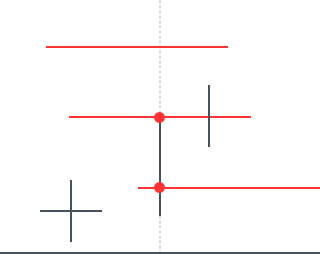
虚线是扫描线,黑线是给定的水平线和垂直线,红线是任意时刻与扫描线相交的水平线。
我们的算法如下:
1. 当我们击中水平线段的起点时,我们将线(在我们的实现中,我们将插入起点)插入到我们的集合中。
2. 当我们击中水平线段的终点时,我们从集合中移除线段(实现中线段的起点)。
3. 当我们碰到一条垂直线时,我们检查集合中位于垂直线段起始和结束 y 坐标之间的所有线段,即,如果垂直线段由 (x1,y1) 和 (x1) 表示,y2), 我们检查位于 (y1,y2) 范围内的水平线段。
这就完成了我们的算法。那么,让我们跳到实现部分:
#define x second
#define y first
typedef pairpoint;
struct event
{point p1,p2;int type;event() {};event(point p1,point p2, int type) : p1(p1), p2(p2),type(type) {}; //initialization of event
};
int n,e;
event events[MAX];
bool compare(event a, event b)
{ return a.p1.xs;
void hv_intersection()
{for (int i=0;iy<=c.p2.y; it++) // Range searchprintf("%d, %d\n", events[i].p1.x, it->y);//intersections}}
}
int main ()
{scanf("%d", &n);int p1x,p1y,p2x,p2y;for (int i=0;i 复杂度分析:所有对事件的操作(insert,erase, lower_bound)都需要O(log(N))
时间,内循环运行 k 次,其中 k 是交叉点的数量。因此,上述算法的复杂度为O(Nlog(N)+k)
所以,下一个想到的问题是如果 k 是O(N*2),所以在那种情况下我们的算法运行缓慢。这是对的,但想想如果我们有路口,然后我们得到相当大的加速。其次,如果我们只需要交叉点的数量而不是交叉点本身会怎么样。然后我们可以找到交叉点的数量使用二叉树结构的时间(通过将子树的大小存储在子树的根中)。
2.2 将问题复杂化线条不垂直的交点
让我们回到我们的问题,线条不一定是垂直或水平的。在那种情况下该怎么办?
A: 首先,让我们列出算法中的假设:
1.没有垂直线段。
2. 没有两条线段在它们的端点处相交。
3. 没有三个(或更多)路段有共同的交叉点。
4.线段的所有端点和所有交点具有不同的x坐标。
5. 没有两个段重叠。
B :主要相交性判别原理:
1. 两条线相交,它们必须彼此相邻。因此,我们将只检查相邻线是否相交。
2. 当两条线段相交时,它们改变位置,即相交前在下方的线在上方,另一条线在下方。
C: 在开始算法之前,首先让我们定义事件和活动集。
扫描线算法的Events
事件:线段的端点、交点。(我们会在找到它们时插入交点)。在这里,我们将使用优先级队列作为我们的数据结构,因为由于交叉点的动态插入和删除,预排序将不起作用。让我们用 PQ 表示优先级队列
扫描线算法的Active Set
在任何时候,活动集都包含被扫描线切割的线段,按 y 坐标排序。让我们用 SL 表示这个活动集。伪代码:
Initialize PQ = all segment endpoints;Initialize SL to be empty;Initialize output intersection list IL to be empty;While (PQ is nonempty) {Let E = the next event from PQ;If (E is a left endpoint) {Let segE = segment of E;Add segE to SL;Let segA = the segment Above segE in SL;Let segB = the segment Below segE in SL;If (I = Intersect( segB with segA) exists) Delete I from PQ;If (I = Intersect( segE with segA) exists) Insert I into PQ;If (I = Intersect( segE with segB) exists) Insert I into PQ;}Else If (E is a right endpoint) {Let segE = segment of E;Let segA = the segment Above segE in SL;Let segB = the segment Below segE in SL;Delete segE from SL;If (I = Intersect( segA with segB) exists) Insert I into PQ;}Else { // E is an intersection eventAdd intersect point of E to the output list IL;Let segE1 above segE2 be intersecting segments of E in SL;Swap their positions so that segE2 is now above segE1;Let segA = the segment above segE2 in SL;Let segB = the segment below segE1 in SL;If (I = Intersect( segE1 with segA) exists) Delete I from PQ;If (I = Intersect( segE2 with segB) exists) Delete I from PQ;If (I = Intersect(segE2 with segA) exists)Insert I into PQ;If (I = Intersect(segE1 with segB) exists) Insert I into PQ;}remove E from PQ;}return IL;
}那是 Bentley Ottmann 算法,用于在给定 N 条线段时找到所有交叉点。让我们看一下图像以更好地理解它。
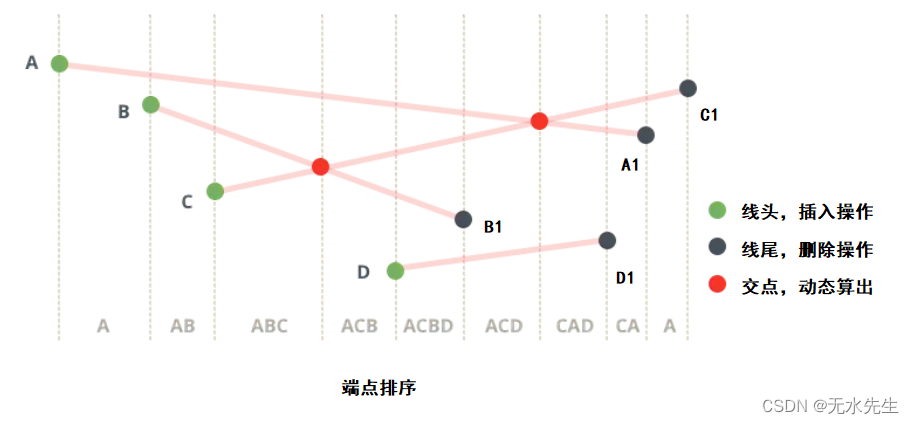
算法详解:
1)输入线段:( P(x,y),P1(x,y))循环输入全部线段用PP1表示。
2)对所有的线段端点(包括P和P1)按照x坐标排序,上图排序结果是:
PQ = 【 A,B,C,D,B1,D1,A1,C1】
3)我们提取 PQ 中的最小值并将其作为我们的事件。所以,我们知道这个事件可能是左端点、右端点或交点。如图:扫描线对PQ扫描,扫到A
 A进入队列,(A是第一个点)
A进入队列,(A是第一个点)
List = 【A】 表示唯一线段是A为起始点。
- 1 扫描线继续扫描PQ,找到B,比较A与扫描线交点W和B的y坐标,y(Wa)>y(B),表明A线段在B点上方,所以:
List = 【A,B】
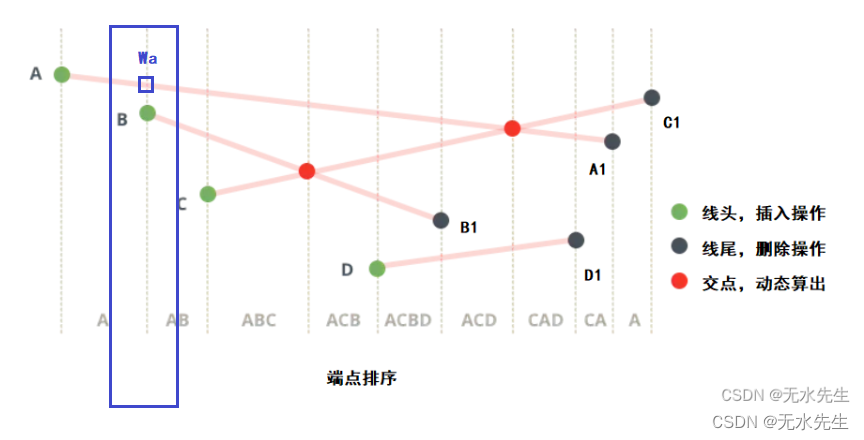
- 2 继续扫描PQ序列,读出C点,因为y(C)
List = 【A,B,C】
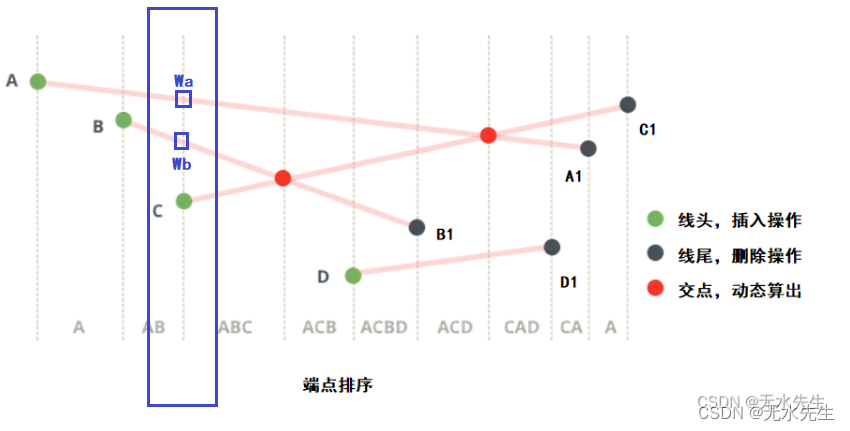
- 3 继续扫描PQ序列,读出D点,此时,扫描线对应的交点按照y排序是是Wa,Wc,Wb,D
所以: List = 【A,C,B,D】
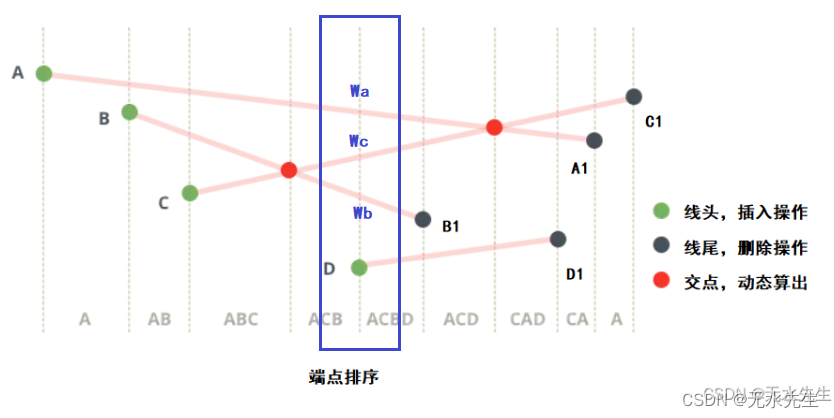
可以观察到,线序从【A,B,C】跳转到 List = 【A,C,B,D】 其中B和C产生一个逆序,因此,B和C有一个交点。(求出该交点保存)
- 4 继续扫描,看到B1点,因为B1点是个后端点,所以删除与之相对应的线段B:于是
List = 【A,C, D】
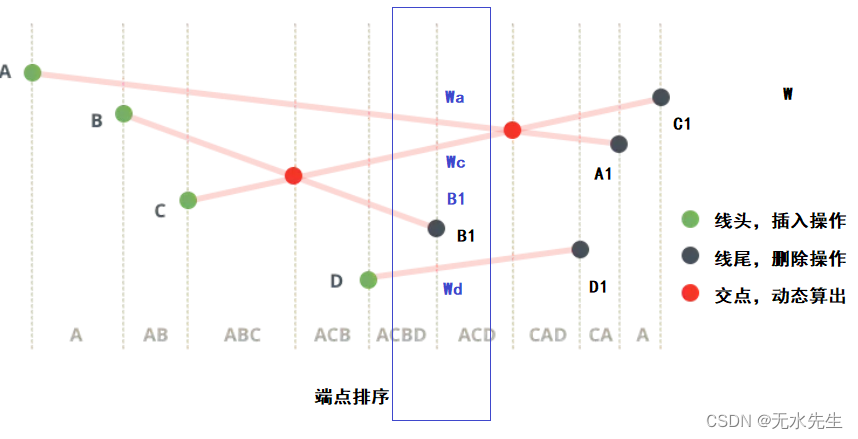
- 5 继续扫描,看到D1点,因为D1点是个后端点,所以删除与之相对应的线段D:计算扫描交点顺序: y(Wc) >y(Wa)
List = 【C,A】这里产生一个逆序,所以A和C两个线段必然相交,求出交点并保存。
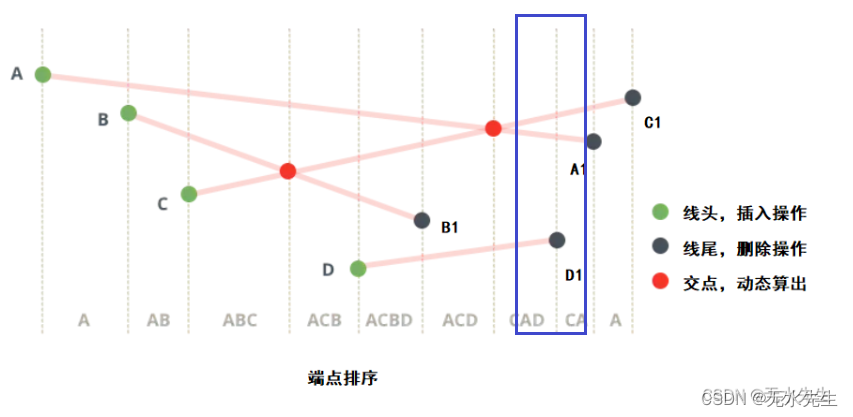
- 6 继续扫描,看到A1点,因为A1点是个后端点,所以删除与之相对应的线段:计算扫描交点顺序: Wc > Wa
List = 【C 】 。
- 7 继续扫描,看到C1点,因为C1点是个后端点,所以删除与之相对应的线段:List = 【 】 。
算法结束。
三、相关实验代码
# lsi.py
# Implementation of the Bentley-Ottmann algorithm, described in deBerg et al, ch. 2.
# See README for more information.
# Author: Sam Lichtenberg
# Email: splichte@princeton.edu
# Date: 09/02/2013 from Q import Q
from T import T
from helper import *# "close enough" for floating point
ev = 0.00000001# how much lower to get the x of a segment, to determine which of a set of segments is the farthest right/left
lower_check = 100# gets the point on a segment at a lower y value.
def getNextPoint(p, seg, y_lower):p1 = seg[0]p2 = seg[1]if (p1[0]-p2[0])==0:return (p[0]+10, p[1])slope = float(p1[1]-p2[1])/(p1[0]-p2[0])if slope==0:return (p1[0], p[1]-y_lower)y = p[1]-y_lowerx = p1[0]-(p1[1]-y)/slopereturn (x, y)"""
for each event point:U_p = segments that have p as an upper endpointC_p = segments that contain pL_p = segments that have p as a lower endpoint
"""
def handle_event_point(p, segs, q, t, intersections):rightmost = (float("-inf"), 0)rightmost_seg = Noneleftmost = (float("inf"), 0) leftmost_seg = NoneU_p = segs(C_p, L_p) = t.contain_p(p)merge_all = U_p+C_p+L_pif len(merge_all) > 1:intersections[p] = []for s in merge_all:intersections[p].append(s) merge_CL = C_p+L_pmerge_UC = U_p+C_pfor s in merge_CL:# deletes at a point slightly above (to break ties) - where seg is located in tree# above intersection pointt.delete(p, s)# put segments into T based on where they are at y-val just below p[1]for s in merge_UC:n = getNextPoint(p, s, lower_check) if n[0] > rightmost[0]:rightmost = n rightmost_seg = sif n[0] < leftmost[0]:leftmost = nleftmost_seg = st.insert(p, s)# means only L_p -> check newly-neighbored segmentsif len(merge_UC) == 0:neighbors = (t.get_left_neighbor(p), t.get_right_neighbor(p))if neighbors[0] and neighbors[1]:find_new_event(neighbors[0].value, neighbors[1].value, p, q)# of newly inserted pts, find possible intersections to left and rightelse:left_neighbor = t.get_left_neighbor(p)if left_neighbor:find_new_event(left_neighbor.value, leftmost_seg, p, q)right_neighbor = t.get_right_neighbor(p)if right_neighbor:find_new_event(right_neighbor.value, rightmost_seg, p, q)def find_new_event(s1, s2, p, q):i = intersect(s1, s2)if i:if compare_by_y(i, p) == 1:if not q.find(i):q.insert(i, [])# segment is in ((x, y), (x, y)) form
# first pt in a segment should have higher y-val - this is handled in function
def intersection(S):s0 = S[0]if s0[1][1] > s0[0][1]:s0 = (s0[1], s0[0])q = Q(s0[0], [s0])q.insert(s0[1], [])intersections = {}for s in S[1:]:if s[1][1] > s[0][1]:s = (s[1], s[0])q.insert(s[0], [s])q.insert(s[1], [])t = T()while q.key:p, segs = q.get_and_del_min()handle_event_point(p, segs, q, t, intersections)return intersections# Test.py
# Test file for lsi.
# Author: Sam Lichtenberg
# Email: splichte@princeton.edu
# Date: 09/02/2013from lsi import intersection
import random
import time, sys
from helper import *ev = 0.00000001def scale(i):return float(i)use_file = None
try:use_file = sys.argv[2]
except:passif not use_file:S = [] for i in range(int(sys.argv[1])):p1 = (scale(random.randint(0, 1000)), scale(random.randint(0, 1000)))p2 = (scale(random.randint(0, 1000)), scale(random.randint(0, 1000)))s = (p1, p2)S.append(s)f = open('input', 'w')f.write(str(S))f.close()else:f = open(sys.argv[2], 'r')S = eval(f.read())intersections = []
seen = []
vs = False
hs = False
es = False
now = time.time()
for seg1 in S:if approx_equal(seg1[0][0], seg1[1][0], ev):print 'VERTICAL SEG'print ''print ''vs = Trueif approx_equal(seg1[0][1], seg1[1][1], ev):print 'HORIZONTAL SEG'print ''print ''hs = Truefor seg2 in S:if seg1 is not seg2 and segs_equal(seg1, seg2):print 'EQUAL SEGS'print ''print ''es = Trueif seg1 is not seg2 and (seg2, seg1) not in seen:i = intersect(seg1, seg2)if i:intersections.append((i, [seg1, seg2]))# xpts = [seg1[0][0], seg1[1][0], seg2[0][0], seg2[1][0]]# xpts = sorted(xpts)# if (i[0] <= xpts[2] and i[0] >= xpts[1]:# intersections.append((i, [seg1, seg2]))seen.append((seg1, seg2))
later = time.time()
n2time = later-now
print "Line sweep results:"
now = time.time()
lsinters = intersection(S)
inters = []
for k, v in lsinters.iteritems():#print '{0}: {1}'.format(k, v)inters.append(k)
# inters.append(v)
later = time.time()
print 'TIME ELAPSED: {0}'.format(later-now)
print "N^2 comparison results:"
pts_seen = []
highestseen = 0
for i in intersections:seen_already = Falseseen = 0for p in pts_seen:if approx_equal(i[0][0], p[0], ev) and approx_equal(i[0][1], p[1], ev):seen += 1seen_already = Trueif seen > highestseen:highestseen = seenif not seen_already:pts_seen.append(i[0])in_k = Falsefor k in inters:if approx_equal(k[0], i[0][0], ev) and approx_equal(k[1], i[0][1], ev):in_k = Trueif in_k == False:print 'Not in K: {0}: {1}'.format(i[0], i[1])
# print i
print highestseen
print 'TIME ELAPSED: {0}'.format(n2time)
#print 'Missing from line sweep but in N^2:'
#for i in seen:
# matched = False
print len(lsinters)
print len(pts_seen)
if len(lsinters) != len(pts_seen):print 'uh oh!'四、测试代码说明
for more information.Usage:from lsi import intersection# S is a list of tuples of the form: ((x,y), (x,y))
i = intersection(S)This function returns a dictionary of intersection points (keys) and a list of their associated segments (values).Currently, this implementation does not handle horizontal/vertical line segments. This will be changed shortly!A test file is available. It compares the running time of the algorithm to that of a brute-force O(N^2) comparison. It also generates a specified number of random input segments--you can set the precision and range by editing the file.Email at: splichte@princeton.edu